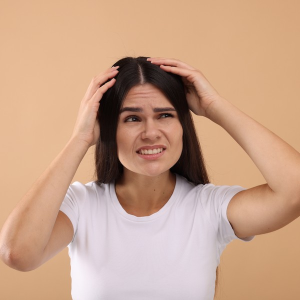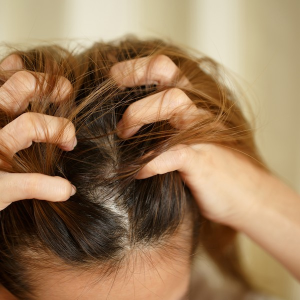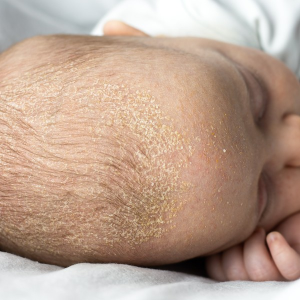Seborrhea - How to recognize and fight it naturally?
Author: Lucie Garabasova
Seborrhea, also known as seborrheic dermatitis, is a chronic skin condition affecting the scalp, face, and sometimes other parts of the body. It causes discomfort like itching and flaking. Lately, natural remedies have been increasingly mentioned in treatment approaches, and this is where hemp products come in handy. In this article, we will explain what causes seborrhea, its symptoms, and how to fight it naturally.
How can I identify seborrhea?
Seborrhea (seborrheic dermatitis) manifests differently depending on its severity and location.
Typical symptoms include:
- Red patches on the skin – Red spots may appear on the face, scalp, behind the ears, or on the chest, which can be slightly swollen.
- Scaling and peeling skin – Affected areas develop greasy, yellowish, or white scales that peel off. The scalp often looks like it's covered in dandruff.
- Itching and irritation – The skin becomes irritated and may itch intensely, especially during excessive sweating.
- Oily and shiny skin – Seborrhea is associated with excessive sebum production, causing a shiny appearance, especially in areas like the forehead, nose, and chin.
- Worsening in winter months or under stress – Seborrhea often flares up seasonally, worsening in colder weather. Stress and hormonal changes can also exacerbate the condition.
These symptoms can fluctuate in intensity – sometimes they worsen, while other times they may disappear for an extended period. Seborrhea is not contagious but can be uncomfortable and affect one's quality of life.
Who is most prone to seborrhea?
Seborrhea can occur in various groups, though certain factors increase the likelihood of its appearance.
-
Newborns and young children – Seborrhea is common in newborns, often referred to as cradle cap. It appears as scaly patches on the scalp, which are harmless and usually resolve within a few months.
-
Adolescents and young adults – Seborrhea often appears during puberty when sebum production increases due to hormonal changes. This period is also typical for the appearance of dandruff, which is a manifestation of seborrhea.
-
Adults in middle age – Seborrhea can manifest in adulthood, particularly in men aged 30–60, when the skin becomes more prone to excessive sebum production and inflammation. It can also occur in women, though less frequently.
-
People with oily skin – Seborrhea is more common in individuals with generally oily skin and hair because their sebaceous glands produce excess sebum.
-
People with weakened immune systems – Seborrhea is more frequent in individuals with weakened immune systems. Those undergoing stress or who are chronically ill are also more susceptible to seborrhea.
-
People with neurological and psychological disorders – Seborrhea often occurs in people with Parkinson’s disease, depression, or other neurological disorders. The exact link between seborrhea and these conditions is not fully understood but is common.
-
Environmental and lifestyle factors – Stress, lack of sleep, poor diet (e.g., lacking essential fatty acids or vitamins), cold weather, or seasonal changes can worsen seborrhea symptoms.
Seborrhea is not contagious and can appear in anyone, though the above factors increase the risk.
Seborrhea treatment
Treatment for seborrhea depends on the severity of the symptoms and the areas of the body affected.
Most cases of seborrhea are treated with a combination of topical medications and shampoos that help reduce inflammation, scaling, and itching.
The most common treatment methods include:
- Medicated shampoos
- Topical corticosteroids (prescribed by a doctor for severe cases)
- Topical antifungal creams
- Phototherapy
- Other prescription medications
- Lifestyle adjustments
Seborrhea vs. seborrheic dermatitis
Seborrhea and seborrheic dermatitis are often used interchangeably, but there is a distinction:
Simply put, seborrhea is only increased sebum production, while seborrheic dermatitis is an inflammatory condition associated with seborrhea but also includes inflammation and other unpleasant symptoms.
Natural treatment of seborrhea: How to soothe the skin without chemicals
- CBD oil (internal use): CBD (cannabidiol) has strong anti-inflammatory properties that can help treat seborrhea. Taking CBD oil internally supports immune system balance and may help regulate excessive sebum production. A few drops daily can help reduce inflammation and itching.
- CBD hair care products: Shampoos and conditioners with CBD and hemp oil are ideal for soothing irritated scalp. CBD promotes regeneration and reduces inflammation, while hemp oil provides hydration and essential fatty acids, helping restore natural balance and prevent flaking.
- Hemp balm for skin: For affected areas outside the scalp, such as the face or chest, hemp balm is an excellent solution. It helps soothe redness, flaking, and itching.
- Jojoba Oil Jojoba oil resembles natural sebum and can calm and nourish the skin. Regular application to affected areas (especially the scalp) can reduce scaling and promote healing.
- Tea Tree Oil This essential oil has natural antifungal and antibacterial properties, making it a popular choice for treating skin problems, including seborrhea. Just add a few drops of tea tree oil to shampoo or dilute it in a carrier oil (such as hemp) and apply it directly to affected areas.
- Aloe Vera Aloe Vera gel is known for its moisturizing and soothing effects. Applying natural Aloe Vera gel directly to affected areas helps reduce redness and flaking.
- Apple Cider Vinegar Apple cider vinegar has antibacterial properties and can help restore the skin’s natural pH. Mix it with water in a 1:1 ratio and apply it to the scalp or other affected areas. Leave it on for 5-10 minutes, then rinse.
- Coconut Oil Coconut oil has strong moisturizing and anti-inflammatory properties. Massage it into the skin or scalp to reduce itching and flaking.
- Omega-3 Fatty Acids Omega-3 fatty acids, found in fish oil, hemp oil, or flax or hemp seeds, can help reduce inflammation and regulate sebum production. Incorporating these fatty acids into your diet, or supplementing them, can improve skin health.
These natural methods, combined with CBD cosmetics and oil, can provide significant relief and help keep seborrhea under control. Remember that consistency and regular care are key to success!
Home Remedies: What Helps with Seborrhea?
Here are a few tried-and-true home remedies for seborrhea that can help alleviate its symptoms naturally:
- Chamomile Tea: Chamomile has natural anti-inflammatory and soothing effects. Brew a strong chamomile tea, let it cool, and use it as a rinse for the scalp or face. Chamomile helps reduce redness and irritation.
- Oatmeal: Oats are known for their soothing effects on the skin. Mix a handful of oats with water to create a paste, and gently apply it to affected areas. Leave it on for 10-15 minutes, then rinse. Oats relieve itching and dryness.
- Honey Mask: Honey is a natural antibacterial and moisturizing agent that can help calm irritated skin and reduce inflammation. Mix honey with a little warm water, apply it to affected areas, and leave it on for 20-30 minutes. Then rinse.
- Nettle Rinse: Nettle has detoxifying and anti-inflammatory properties that can be helpful in treating seborrhea. Prepare a strong infusion of nettles, let it cool, and use it as a rinse for hair or affected skin.
- Vinegar Rinse: Apple cider vinegar is a traditional remedy for many skin problems due to its antibacterial and pH-balancing effects. Dilute apple cider vinegar with water (1:1) and apply it to the scalp or face. Vinegar helps remove excess sebum and reduces itching.
These home remedies can be a useful complement to professional skincare and scalp care when dealing with seborrhea. Natural ingredients often help alleviate symptoms without the use of chemicals.



